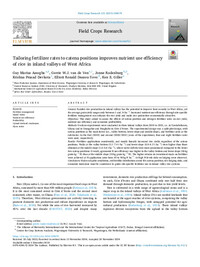Tailoring fertilizer rates to catena positions improves nutrient use efficiency of rice in inland valleys of West Africa

Authors:
Context
Rainfed rice production in inland valleys has the potential to improve food security in West Africa, yet the average grain yield ranges only between 1 and 3 t ha−1. Increased nutrient use efficiency through site-specific fertilizer management can enhance the rice yield and make rice production economically attractive.
Objectives
This study aimed to assess the effects of catena position and nitrogen fertilizer rates on rice yield, nutrient use efficiency and economic profitability.
Methods
On-farm experiments were conducted in three inland valleys from 2019 to 2021, i.e. in Yawtabrikrom, Ghana and in Ouragahio and Pangbabo in Côte d’Ivoire. The experimental design was a split-plot design, with catena positions as the main factor (i.e., valley bottom, lower slope and middle slope), and fertilizer rates as the sub-factor. In the first (2019) and second (2020/2021) years of the experiment, four and eight fertilizer rates were used, respectively.
Results
Fertilizer applications consistently, and mostly linearly increased rice yields regardless of the catena positions. Yields at the valley bottom (2.1–7.4 t ha−1) and lower slope (0.9–6.5 t ha−1) were higher than those obtained at the middle slope (1.0–5.6 t ha−1), where water deficits were more pronounced compared to the lower two catena positions. Overall, agronomic N use efficiency was higher in the valley bottom and lower slope (26 kg grain kg−1 N) than at the middle slope (19 kg grain kg−1 N). The higher returns on investment made on fertilizer were achieved at N application rates from 45 to 90 kg N ha−1. At high N levels risks on lodging were observed.
Conclusions
Hydro-edaphic conditions, soil fertility distribution across the catena position, rice lodging risks, and economic indicators must be considered to guide site-specific fertilizer use in inland valley rice systems.
